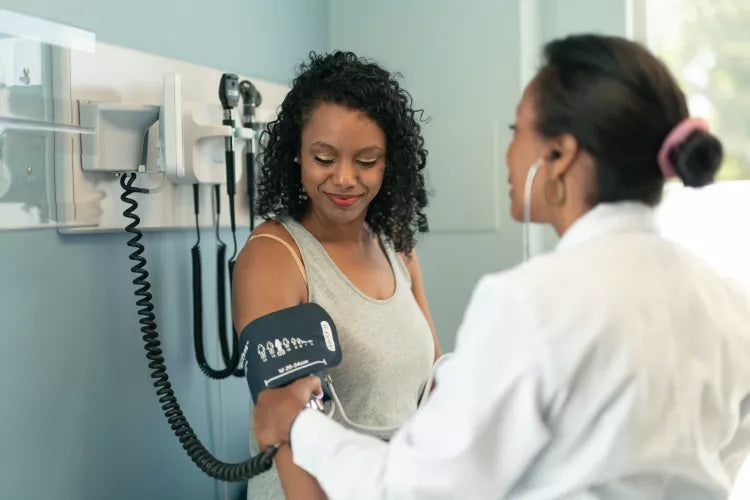
Lower Your Blood Pressure: A Simple Guide for Older Adults
Share
Lower Your Blood Pressure: A Simple Guide for Older Adults
Who this is for
- Adults 60+ who want clear, doable steps
- Family members and caregivers in North America
- Anyone who prefers plain language and short, practical tips
Quick pick: a simple tool that helps every day
MOREPRO® PulseMax 2025 Smartwatch — an easy-to-use blood pressure watch and medical alert smartwatch made for older adults.
- Checks health: heart rate, blood pressure, blood oxygen, sleep, and non-invasive blood sugar trends (a helpful blood sugar monitor watch feature for daily reference).
- Safety: automatic fall detection that detects falls and emergency calling to your emergency contacts for extra peace of mind.
- Stays connected: pairs with your phone; alerts can go through your phone’s Wi-Fi or cellular connection.
- Built for daily life: simple screen, big text, water-resistant, 7–10-day battery.
- Learn more: PulseMax 2025 Smartwatch (product page)
- Best Upgrade MOREPRO® PulseMax Fall Detection Watch With Blood Glucose – MorePro
Why blood pressure matters
High blood pressure (“the silent killer”) raises the risk of heart disease, stroke, and kidney problems. Many people feel fine until a big event happens. The good news: small daily changes help a lot.
For trusted info:
American Heart Association – High Blood Pressure: https://www.heart.org/en/health-topics/high-blood-pressure
National Institute on Aging – Exercise & Physical Activity: https://www.nia.nih.gov/health/exercising-older-adults
10 simple tips that work
1) Manage your weight
Even a 5%–10% weight loss can lower numbers.
Try: more vegetables and fruit, lean protein (chicken, fish, tofu), and whole grains. Move more (see Tip 2).
2) Move most days (even short bouts)
Aim for 150 minutes a week (for example, 30 minutes, 5 days).
Easy picks: brisk walking, swimming, or tai chi.
Stand up every 30 minutes to break long sitting.
NIA guide: https://www.nia.nih.gov/health/exercising-older-adults
3) Go easy on caffeine
Caffeine can spike pressure for some people.
Try: 1 cup of coffee max if you have high BP, or switch to tea/herbal tea.
Mayo Clinic on caffeine: https://www.mayoclinic.org/healthy-lifestyle/nutrition-and-healthy-eating/in-depth/caffeine/art-20045678
4) Cut back on salt (sodium)
Salt holds water in your body and raises pressure.
Do: cook with herbs, lemon, garlic; check labels; pick low-sodium options.
AHA Salt & Sodium: https://www.heart.org/en/health-topics/high-blood-pressure/understanding-blood-pressure-readings/sodium-and-salt
5) If you smoke, make a quit plan
Smoking stiffens arteries and pushes numbers up.
Help: nicotine replacement and support lines work.
CDC quit resources: https://www.cdc.gov/tobacco
6) Limit alcohol
Too much alcohol raises BP.
Guide: up to 1 drink/day for women, 2 for men.
NIAAA: https://www.niaaa.nih.gov
7) Protect your sleep (7–8 hours)
Poor sleep keeps pressure high.
Do: a steady sleep/wake time, dark/cool room, no screens 1 hour before bed.
Sleep Foundation: https://www.sleepfoundation.org
8) Lower daily stress
Stress hormones tighten blood vessels.
Try: 10 minutes of deep breathing, light yoga, short walks, or a call with a friend.
APA stress tips: https://www.apa.org/topics/stress
9) Take medicines as directed
Use a pillbox or phone reminder. Tell your doctor about side effects—never stop on your own.
10) Work with your care team
Bring home BP logs to visits. Ask about goals and next steps. Your treatment plan should fit your life and budget.
When to call for help
- Call 911 / local emergency services now for chest pain, severe headache, trouble breathing, weakness on one side, confusion, or a hypertensive emergency (very high numbers with symptoms).
- Call your clinic soon if home readings stay high (for many adults, ≥130/80 mmHg as a target—your doctor may set a different goal).
Make home tracking easy (and safer)
A tool you actually wear beats a device left in a drawer. The PulseMax 2025 combines a fitness tracker/activity tracker with heart rate and blood pressure monitor with fall detection technology—so health and safety live on one wearable device.
Why older adults and family members like it
- Checks heart rate, blood pressure, SpO₂, sleep; shows trends to share with your doctor.
- Automatic fall detection and medical alert watch functions offer quick help if someone has fallen and can’t get up.
- Simple setup; clear screen; long battery; water resistance for daily life.
- Acts like a medical alert device without monthly fees for the core features (see store details). Works alongside traditional medical alert devices and systems with fall detection if you prefer a staffed response center.
See PulseMax again:
Best Upgrade MOREPRO® PulseMax Fall Detection Watch With Blood Glucose – MorePro
Quick FAQ (plain answers)
Q: Is it hard to set up?
A: No. Pair by Bluetooth, add emergency contacts, test fall detection once.
Q: Does it call for help?
A: It can alert your contacts and share location through your phone’s connection (Wi-Fi/cellular). For a staffed line, some people also keep a dedicated medical alert device.
Q: Is it water resistant?
A: Yes, for daily use (hand-washing, light rain). Check the product page for details.
One small step today
Pick one tip to start (salt, steps, or sleep). Log your numbers for a week. Share the results with your doctor. Tools like PulseMax 2025 make it easier to stick with it—and give everyone at home a little more peace of mind.
Best Upgrade MOREPRO® PulseMax Fall Detection Watch With Blood Glucose – MorePro
